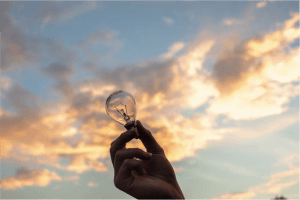The Hidden Dangers of Mercury Light Bulbs: What You Need to Know
By Leah • Nov 28, 2018
With so many different lighting options available on the market today, it can be hard to know which one is right for your business. What’s important to remember is not all lighting solutions are created equal. In fact, many warehouses, studios, factories, and commercial buildings are still fixed with outdated lighting solutions that not only waste energy, but may also be hazardous to your health.
Mercury lights are one such solution. While they might offer brightness and proper illumination, mercury in light bulbs can also be dangerous in some cases. In this article, we will dive into why light bulbs with mercury aren't the best choice for your home or office, exploring their dangers and also provide a list of safer alternatives.
Understanding Mercury Lights: How Do They Work?
Mercury lights, commonly found in fluorescent lamps, compact fluorescent bulbs (CFL bulbs), metal halide, and high pressures sodium lamps operate using a process that involves mercury vapor. When you switch on a mercury-containing light bulb, an electric current passes through the gas inside the bulb, which excites the mercury vapor. This process causes the mercury vapor light bulb to emit ultraviolet (UV) light. The UV light then interacts with the phosphor coating on the inside of the fluorescent bulb, producing visible light. Despite the presence of toxic mercury, fluorescent lamps are widely used.
How Much Mercury Is in Light Bulbs?
The amount of mercury in light bulbs varies depending on the type and manufacturer. On average, a compact fluorescent lamp (CFL) contains about 3-5 milligrams of mercury, a standard fluorescent tube can contain between 3.5 to 12 milligrams, and industrial metal halide or high pressure sodium bulbs contain between 50-100 milligrams of mercury . Although this amount may seem small, mercury is a potent neurotoxin, and even tiny quantities can be harmful. The mercury content in these bulbs is crucial for their operation, but it also means that improper disposal can lead to significant contamination.
Handling and disposing of mercury-containing light bulbs properly is essential to protect both human health and the environment. As awareness of the risks associated with mercury in light bulbs grows, many consumers are switching to safer, more eco-friendly lighting options like LED bulbs. This shift not only reduces the potential for mercury poisoning but also supports broader environmental protection efforts.
What Are the Dangers of Mercury Vapor?The problem with mercury gas and its usage in light bulbs is that it is highly toxic. However, the gas is only a threat itself if the light bulb breaks or is damaged in any way.When a mercury bulb breaks, the toxic gas is released into the air. This can be inhaled by a person and cause serious damage in acute doses.While it's important to handle broken mercury containing bulbs with care, the actual risk in home settings is relatively low. However, the situation is more complex in industrial environments. Large high-intensity discharge bulbs, such as metal halide lamps, contain more mercury, and if they break in an enclosed space, the gas release can be much more dangerous. Additionally, the sheer number of bulbs used in industrial settings amplifies the risk.
Another significant concern is defective bulbs that may slowly leak mercury vapor into the work environment. This hidden danger is particularly alarming because the gas is invisible, and you won't be aware of the leak until it has already contaminated the air. Taking these factors into account, it's clear that mercury exposure from lighting in industrial settings requires stringent safety measures and careful monitoring.

The Problem With Mercury Vapor Lamps
Aside from its potential health and environmental threats, mercury vapor lamps are simply not the most efficient, safe, and cost-effective solutions on the market today. As they use gas to allow their bulbs to work, they are much less inefficient, they waste electrical energy on useless heat energy and they depreciate in quality much more quickly than LED bulbs. In today’s developed and advanced lighting industry, light bulbs and mercury are simply a thing of the past. Which is why now is the perfect time to upgrade to LED lighting fixtures.Or LED bulbs.
Safer Alternatives to Mercury Light Bulbs: Switching to LED Lights
You might be wondering, “Do LED bulbs contain mercury?” The answer is no, LED lights offer a safer and more efficient alternative compared to light bulbs with mercury. Unlike mercury vapor bulbs, LEDs do not lose lumens over short periods, ensuring excellent lumen maintenance. This characteristic makes LEDs much more energy-efficient and cost-effective in the long run. Their light quality is not only comparable but also more versatile, with instant illumination when switched on.
While mercury lighting has its defenders, LED lighting is entirely safe, eliminating the risks associated with mercury exposure. Furthermore, outdoor and indoor LED lights have advanced significantly, and their costs have decreased, making them an affordable option for everyone.
LEDs also boast easy installation options. With direct replacement, plug-and-play led lamps and simple ballast bypass bulbs, switching from mercury vapor light bulbs to LED lighting is straightforward. There’s no longer any compelling reason to use mercury-containing bulbs, especially when considering the numerous advantages of LEDs.
Benefits of Switching to LEDs
- Energy Efficiency: LED lights use significantly less energy than mercury-containing bulbs, which translates to lower electricity bills and a reduced carbon footprint.
- Longevity: LEDs have a much longer lifespan, often lasting tens of thousands of hours, reducing the frequency and cost of replacements.
- Environmental Impact: Since LEDs do not contain toxic mercury, they are much safer for the environment. They also produce less waste due to their long lifespan.
- Light Quality: LEDs offer superior light quality, with options for various color temperatures and dimmability, making them suitable for a wide range of applications.
- Instant Lighting: Unlike some fluorescent lamps that take time to warm up, LEDs provide full brightness instantly, enhancing convenience and safety.
- Durability: LEDs are more robust and less susceptible to breaking compared to traditional glass bulbs, making them ideal for both residential and industrial settings.
Switching to LED lighting is not just about safety—it's about embracing a brighter, more efficient, and environmentally friendly future.
Finding the Right LED Lighting Solution With OEO
Upgrading to LED lighting is not only a step towards better energy efficiency and cost savings but also a move towards a safer and more environmentally friendly lighting solution. OEO Energy Solutions offers some of the best LED lighting on the market, ensuring durability and superior light quality. Our wide range of LED products caters to various needs, providing instant illumination and long-lasting performance.
Whether you’re shopping for new LED High Bay Fixtures, LED Panel Lights, or Retrofit Lamps, our online selection of lighting products has everything you need to illuminate your space. By choosing OEO's LED lighting solutions, you are investing in a brighter, safer, and more sustainable future for your home or business.
